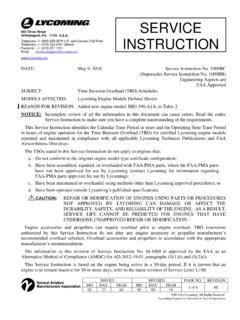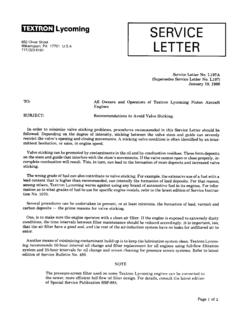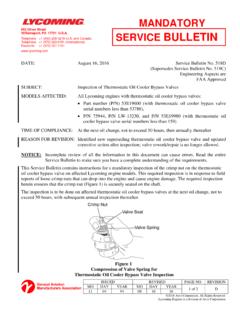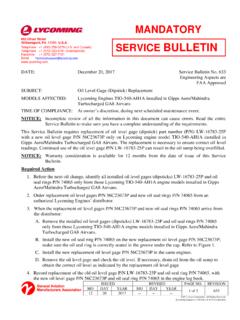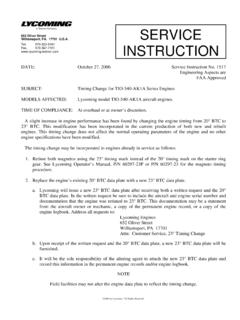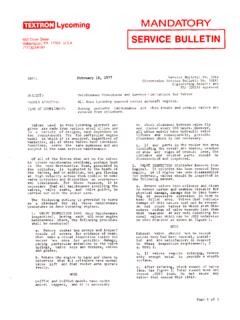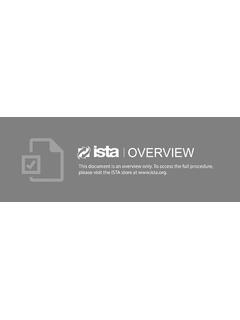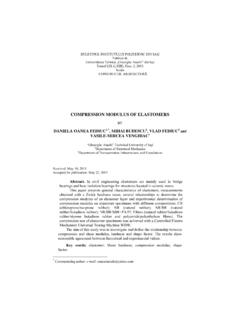Transcription of Cylinder Compression - Lycoming
1 TEXTRON Lycoming SERVICE652 Oliver StreetWilliamsport, PA 17701 : September 28, 1998 Service Instruction No. 1191A(Supersedes Service Instruction No. 1191)Engineering Aspects areFAA ApprovedSUBJECT: Cylinder CompressionMODELS AFFECTED: All Textron Lycoming aircraft OF COMPLIANCE: As required to determine Cylinder condition of the working parts in the combustion chamber of a Cylinder can be determined by measuringthe static leak rate of the Cylinder as compared to the leak rate through an orifice of specified size. This is accom-plished by attaching a differential Compression measuring device, which incorporates the orifice, to one sparkplug hole of the Cylinder while the piston is at top center of the Compression ALL NECESSARY PRECAUTIONS AGAINST ACCIDENTAL FIRING OR ROTA-TION OF THE piston is held at top dead center by firmly holding the propeller to prevent the engine from turning whenair pressure is applied through the differential Compression device to the combustion GLOVES OR RAGS TO PROTECT THE HANDS WHILE HOLDING THE PROPEL-LER BLADE.
2 ALSO, BEFORE ATTACHING THE Compression tester , CHECK THEAIR SUPPLY REGULATOR TO MAKE SURE THE AIR PRESSURE TO THE CYLINDERIS NOT EXCESSIVE. AIR PRESSURE IN THE Cylinder CAN CAUSE THE PROPEL-LER TO TURN; KEEP CLEAR OF THE PATH OF THE assure that the piston rings are seated, the propeller is moved slightly back and forth with a rocking motionwhile air pressure is applied; thus providing a more accurate reading. Meanwhile, a second person adjusts theair supply pressure to 80 psi, indicated on the supply pressure gage of the differential Compression device. Then,observation of the engine Cylinder pressure gage will give an indication of the condition of the parts in the com-bustion chamber of the orifice size of the differential Compression measuring device is critical if consistent andmeaningful Cylinder analysis are to be obtained; the larger the orifice the less chance of detectingpotential problems.
3 Therefore, a specific orifice size that provides an acceptable leak rate hasbeen selected for all Textron Lycoming engines; the instructions described herein are based onthis orifice which is .040 in. dia. (No. 60 drill) x .250 in long, with entrance angle of 59/60 .At any time loss of power, increasing oil consumption, hard starting or other evidence of unexplained abnor-mal operation is encountered, a Compression check of the cylinders is recommended with equipment and in themanner described above by personnel experienced with the equipment and with the type of engine to bechecked. In practice the procedure is as follows:General Aviation Page 1 of 2 Manufacturers AssociationService Instruction No. 1191 AAIR SUPPLY PRESSUREENGINE Cylinder PRESSUREAIR TO ENGINE Cylinder AIR SUPPLY PRESSURE REGULATORAIR SUPPLYT ypical Differential Compression Measuring the engine until normal Cylinder head and oil temperatures are attained; then shut down the enginemaking sure that magneto switches and fuel supply valves are shut off.
4 Proceed with the test as soon as pos-sible after shut Conduct the test in accordance with the test equipment manufacturer's Interpretation of the results of the test is highly dependent on the skill and judicious opinion of the tester ;however, the following observations cover the principle factors to be noted:a. Pressure readings for all cylinders should be nearly equal; a difference of 5 psi is satisfactory; a differenceof 10 to 15 psi indicates an investigation should be the pressure difference exceeds 15 psi the investigation should not necessarily mean re-moval of the Cylinder ; often a valve will reseat itself and result in acceptable Compression duringa later check which should be made within the next 10 hours of If the pressure reading for all cylinders is equal and above 70 psi; the engine is satisfactory; less then65 psi indicates wear has occurred and subsequent Compression checks should be made at 100 hour intervalsto determine rate and amount of wear.
5 If the pressure reading is below 60 psi or if the wear rate increasesrapidly, as indicated by appreciable decrease in Cylinder pressure, removal and overhaul of the cylindersshould be Low pressure in a single Cylinder is indicative of air passing by the piston or by the Air discharged from the breather or oil filler tube indicates leakage in the area of the piston and Air discharged through the intake system indicates leakage at the intake Air discharged from the exhaust system indicates leakage at the exhaust 2 of 2
